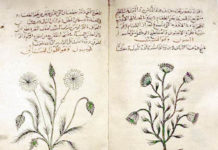In recent years, the so-called Golden Triangle of parts of Laos, northern Thailand and Myanmar (Burma) has become well-known as a leading exporter of opium and its derivatives, including heroin. It is consequently assumed by many people that opium has always come from that area and that the people of the region have historically carried out in an illegal and very damaging trade. This would very unfair.
Opium was originally native to Turkey and was well-known in the Mediterranean world of the Roman Empire. Its use appears to have spread eastwards gradually over the early centuries of the CE and reached China around C7th CE. In East Asia, opium was considered to be an important therapeutic tool in the treatment of various illnesses. Buddhist precepts that have been so influential in shaping the way people in the region have thought caution against the over use of narcotics (and other stimulants such as alcohol), although there is little evidence that misuse was in any way widespread. An edict in the former Thai capital of Ayutthaya from the C14th CE forbids the use and trade of opium but no such edicts were issued in China for another three hundred years. Historically, people would have ingested opium in tablet form or else added it to some beverage. It was not until European explorers found Native Americans smoking tobacco in pipes that the idea of smoking opium emerged. The potency and popularity of the drug increased greatly as a result of this.
European travellers in East Asia report some usage of opium in the imperial age but almost entirely in moderation and for medicinal purposes. The smoking of opium only became a significant activity in China after importing of opium on a large scale into the country by British merchants. The British desired Chinese tea and silk but found there were few western goods that the Chinese wished to purchase in exchange, apart from quantities of precious metals, principally silver. Opium, grown in India under British supervision, provided a suitable alternative – suitable for the importers, in any case. When the Chinese government rejected the trade and attempted to ban the use of opium, the western powers, citing the benefits of free trade, fought two Opium Wars with the Chinese and successfully forced them to sign treaties accepting the unregulated import of opium.
To try to reduce the dependence on these imports, the Chinese government was forced to resort to encouraging the growth of opium poppies of its own in the southern province of Yunnan. Chinese of the numerous ethnic groups of Yunnan have been migrating southwards for a thousand years and from this time many brought their opium use and knowledge with them. Hill tribes moving into northern Thailand and Laos, denied citizenship or else in conflict with the central state, have in some cases turned to the cultivation of opium poppies as a source of revenue, sometimes in the desire to purchase weapons to continue an armed struggle.
In China, the vice of opium smoking, which claimed the lives, health and livelihoods of millions in the subsequent centuries, was only effectively ended when the Communists took power after the 1949 revolution and banned opium in all its forms. Criminalisation of opiates has been enacted in most countries, while industrial chemistry techniques have enabled the rapid widespread distribution of heroin, which is derived from opium. Heroin is much more easily concealed than opium and, being in concentrated form, is capable of yielding higher profits.
At the same time, imperial colonial officers throughout mainland Southeast Asia presided over the significant growth of opium usage in the region either through indifference or as a means of supplementing personal income. A further boost to production and international distribution occurred with the initiation of the US war in Vietnam, during which large numbers of overseas combatants and non-combatants spent extended periods of time in the region and hugely increased the demand for recreational drugs for several years, thereby stimulating an increase in supply capacity.
In recent years, attempts to eradicate opium growing in the highlands of the Golden Triangle have included schemes to provide alternative cash crops from which the people can provide regular and sufficient revenue. These schemes have achieved some limited success but failed to address the demand issues that will stimulate continued production and have intensified the suspicion and dislike felt by the majority lowland peoples for ethnic minority highlanders.
Reference
- Renard, Ronald D., “The Making of a Problem: Narcotics in Mainland Southeast Asia,” in Don McCaskill and Ken Kampe, Development or Domestication? Indigenous Peoples of Southeast Asia (Chiang Mai: Silkworm Books, 1997), pp.307-28.








